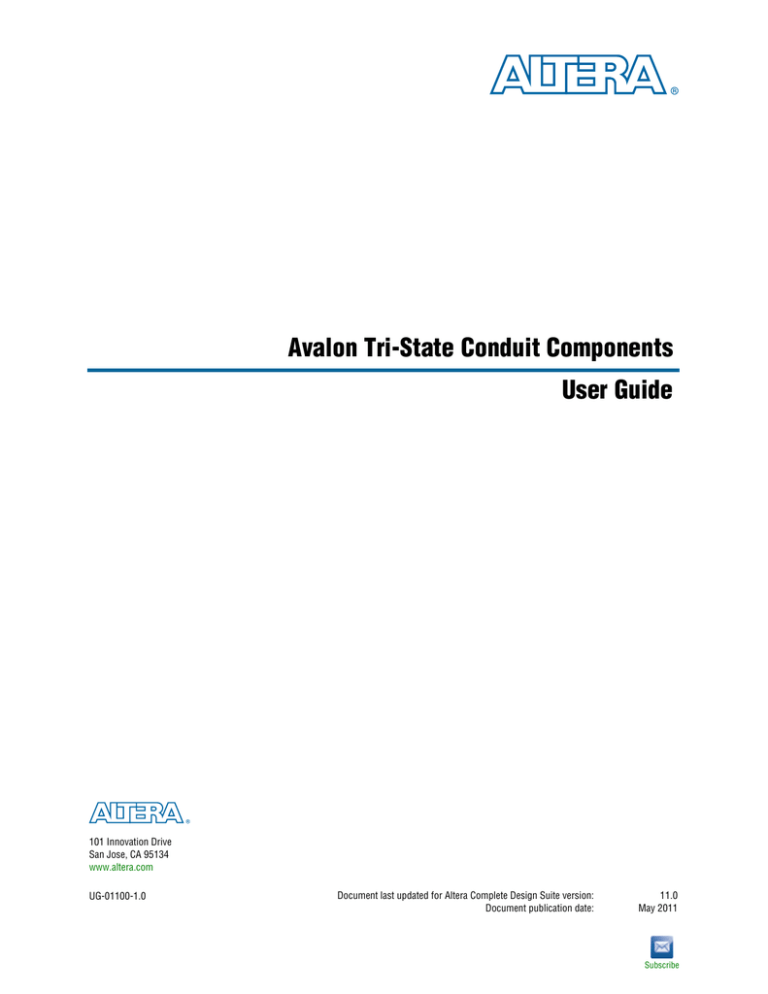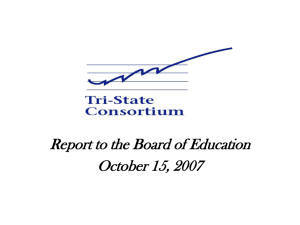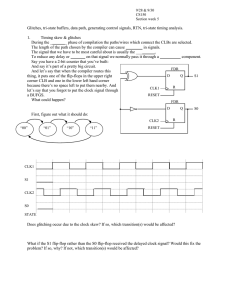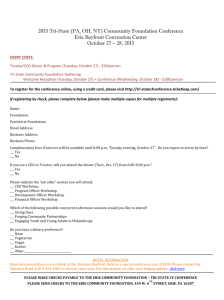
Avalon Tri-State Conduit Components User Guide
Avalon Tri-State Conduit Components
User Guide
101 Innovation Drive
San Jose, CA 95134
www.altera.com
UG-01100-1.0
Document last updated for Altera Complete Design Suite version:
Document publication date:
11.0
May 2011
Subscribe
© 2011 Altera Corporation. All rights reserved. ALTERA, ARRIA, CYCLONE, HARDCOPY, MAX, MEGACORE, NIOS, QUARTUS and STRATIX are Reg. U.S. Pat.
& Tm. Off. and/or trademarks of Altera Corporation in the U.S. and other countries. All other trademarks and service marks are the property of their respective
holders as described at www.altera.com/common/legal.html. Altera warrants performance of its semiconductor products to current specifications in accordance
with Altera’s standard warranty, but reserves the right to make changes to any products and services at any time without notice. Altera assumes no responsibility or
liability arising out of the application or use of any information, product, or service described herein except as expressly agreed to in writing by Altera. Altera
customers are advised to obtain the latest version of device specifications before relying on any published information and before placing orders for products or
services.
Avalon Tri-State Conduit Components User Guide
May 2011 Altera Corporation
Contents
Chapter 1. Avalon Tri-State Conduit Components
Chapter 2. Generic Tri-State Controller
Parameters . . . . . . . . . . . . . . . . . . . . . . . . . . . . . . . . . . . . . . . . . . . . . . . . . . . . . . . . . . . . . . . . . . . . . . . . . . . . . 2–2
Example Read and Write Using Setup, Hold and Wait Times . . . . . . . . . . . . . . . . . . . . . . . . . . . . . . . . . . 2–5
Chapter 3. Tri-State Conduit Pin Sharer
Signal Naming . . . . . . . . . . . . . . . . . . . . . . . . . . . . . . . . . . . . . . . . . . . . . . . . . . . . . . . . . . . . . . . . . . . . . . . . . . 3–1
Parameters . . . . . . . . . . . . . . . . . . . . . . . . . . . . . . . . . . . . . . . . . . . . . . . . . . . . . . . . . . . . . . . . . . . . . . . . . . . . . 3–2
Signal Behavior During Reset . . . . . . . . . . . . . . . . . . . . . . . . . . . . . . . . . . . . . . . . . . . . . . . . . . . . . . . . . . . . . 3–2
Arbitration . . . . . . . . . . . . . . . . . . . . . . . . . . . . . . . . . . . . . . . . . . . . . . . . . . . . . . . . . . . . . . . . . . . . . . . . . . . . . 3–3
Hierarchical Pin Sharing . . . . . . . . . . . . . . . . . . . . . . . . . . . . . . . . . . . . . . . . . . . . . . . . . . . . . . . . . . . . . . . . . 3–4
Additional Information
Document Revision History . . . . . . . . . . . . . . . . . . . . . . . . . . . . . . . . . . . . . . . . . . . . . . . . . . . . . . . . . . . Info–1
How to Contact Altera . . . . . . . . . . . . . . . . . . . . . . . . . . . . . . . . . . . . . . . . . . . . . . . . . . . . . . . . . . . . . . . . Info–1
Typographic Conventions . . . . . . . . . . . . . . . . . . . . . . . . . . . . . . . . . . . . . . . . . . . . . . . . . . . . . . . . . . . . . Info–1
May 2011
Altera Corporation
Avalon Tri-State Conduit Components User Guide
Preliminary
iv
Contents
Avalon Tri-State Conduit Components User Guide
May 2011 Altera Corporation
Preliminary
1. Avalon Tri-State Conduit Components
The Avalon® Tri-State Conduit components available in the Qsys component library
allow you to create on-chip controllers that connect to off-chip devices: The Generic
Tri-State Conduit Controller includes parameters that you can specify to control the
connected off-chip device, frequently a memory device. The Tri-State Conduit Pin
Sharer arbitrates between multiple connected tri-state controllers. It drives signals
from the selected controller to the Tri-State Conduit Bridge. The Tri-State Conduit
Bridge converts an on-chip encoding of tri-state signals into true bidirectional signals
on the PCB. Figure 1–1 illustrates the use of these three Qsys components in an
Altera® FPGA.
Figure 1–1. Qsys System Using the Generic Tri-State Controller, Tri-State Conduit Pin Sharer and Bridge
Altera FPGA
TCM Tristate Conduit Master
Tristate Conduit
Pin Sharer
TCS Tristate Conduit Slave
Tristate Conduit
Bridge
TCM
S
TCS
Avalon-MM Slave
Generic Tristate
Controller
Customized
for 2 MByte
x32 SSRAM
Avalon-MM
Master
S
TCM
TCS
CS
chipselect_out
A[20:0]
D_EN
D[31:0]
DI[31:0]
Rd
Wr
Request
Grant
addr_out[20:0]
data_outen
data_out[31:0]
data_in[31:0]
read_out
write_out
request
grant
chipselect_out
request
grant
addr_out<n>
clock
Arb
data_outen<n>
data_out<n>
data_in<n>
read_out
Generic Tristate
Controller
Customized
for 8 MByte
x16 Flash
S
write_out
TCS
TCM
Grant
Req
A[22:0]
D_EN
D[15:0]
DI[15:0]
Rd
Wr
grant
request
addr_out[22:0]
data_outen
data_out[15:0]
data_in[15:0]
read_out
write_out
CS
IRQ
chipselect_out
irq_in
Note (1)
chipselect_out
irq_in
Note to Figure 1–1:
(1) Refer to Figure 3–3 on page 3–2 for details of the logic that controls read_out and write_out.
May 2011
Altera Corporation
Avalon Tri-State Conduit Components User Guide
Preliminary
1–2
Chapter 1: Avalon Tri-State Conduit Components
In Figure 1–1 two instances of the Generic Tri-State Controller are customized to
control off-chip SSRAM and flash memories. The Avalon Tri-state Conduit
(Avalon-TC) master interfaces of these components connect to separate Avalon-TC
slave interfaces of the Tri-State Conduit Pin Sharer. The Tri-State Conduit Pin Sharer
arbitrates between the connected masters and drives signals from the selected master
on its Avalon-TC interface which connects to the Avalon-TC slave interface of the
Tri-State Conduit Bridge. Finally, the Tri-State Conduit Bridge converts the on-chip
representation of the signals to bidirectional signals. It drives the bidirectional signals
over its Avalon Conduit Interface to SSRAM and flash devices on the PCB. Figure 1–2
shows this system in Qsys with the addition of a Nios II processor that drives the
Avalon-MM slave interfaces of the customized controllers.
Figure 1–2. Qsys Tri-State Conduit System
This user guide explains how to use the Generic Tri-State Controller and Tri-State
Conduit Pin Sharer to create systems that interface to off-chip devices. It does not
include a separate chapter for the Tri-State Conduit Bridge because the sole purpose
of this device is to convert between the on-chip and off-chip representation of
connected signals. After reading this user guide, you should be able to define
controllers that interface with off-chip devices and identify signals that can be shared
between interfaces to reduce the total pin count of your FPGA. This document
includes the following chapters:
■
Generic Tri-State Controller
■
Tri-State Conduit Pin Sharer
Avalon Tri-State Conduit Components User Guide
May 2011 Altera Corporation
Preliminary
2. Generic Tri-State Controller
The Generic Tri-State Controller provides a template for a controller that you can
parameterize to reflect the behavior of an off-chip device. This component includes
the following four interfaces:
■
Avalon Memory-Mapped (Avalon-MM) slave—This is the interface that connects
to an Avalon-MM master, typically an embedded processor which sends read and
write requests to the Generic Tri-State Controller.
■
Avalon-TC master—This is an interface that connects to the Tri-State Conduit Pin
Sharer or Tri-State Conduit Bridge if pin multiplexing is not required. You easily
parameterize the core to utilize enable any subset of the available signals as
required by your off-chip device.
■
Avalon Clock sink—This is a clock sink interface. All Generic Tri-State Controllers
connected to a single Tri-State Conduit Pin Sharer must operate in the same clock
domain.
■
Avalon Reset sink—This a reset sink interface. All Generic Tri-State Controllers
connected to a single Tri-State Conduit Pin Sharer must operate in the same reset
domain.
Figure 2–1 illustrates the Generic Tri-State Controller interfaces and signals. This
figure shows a typical set of signals for the Avalon-MM slave interface. It shows all of
the possible signals for the Avalon-TC interface. Only the request and grant signals
of the Avalon-TC interface are required.
Figure 2–1. Available Signals for the Generic Tri-state Controller
Generic Tri-State Controller - Available Signals
Avalon-MM
Slave
avalon_mm_address[<n>-1:0]
avalon_mm_byteenable[<n>-1:0]
avalon_mm_writedata[<n>-1:0]
avalon_mm_readdata[<n>-1:0]
readdatavalid
lock
avalon_mm_write
avalon_mm_read
avalon_mm_waitrequest
Avalon Clock
avalon_mm_clk
Avalon Reset
avalon_mm_clk_reset
May 2011
request
grant
data[<n>-1:0]_in
data[<n>-1:0]_out
data_outen
read_out
write_out
begintransfer_out
byteenable[<n>-1:0]_out
chipselect_out
lock_out
address[<n>-1:0]_out
waitrequest_in
writebyteenable[<n>-1:0]_out
outputenable_out
resetrequest_in
irq_in_in
reset_out
Altera Corporation
Required
Optional
Avalon-TC
to
Tri-state Conduit
Pin Sharer
Avalon Tri-State Conduit Components User Guide
Preliminary
2–2
Chapter 2: Generic Tri-State Controller
Parameters
Parameters
The Generic Tri-State Controller provides preset configurations for many commonly
used external devices. If you select one of the preset configurations, all of the
parameters are automatically assigned the correct values. Many preset configurations
are available, including presets for all of the following devices:
■
Legacy AMD 29LV065D Flash
■
AMD 29LV128M Flash with Legacy SDK support
■
Intel 128P30 Flash
■
Intel 256P30 Flash
■
SST39VF20090 Flash
■
Flash Memory Interface (CFI)
■
ISSI IS61LPS25636A-200TQL1 SSRAM
■
Cypress CY7C1380C SSRAM
■
IDT71V416 SRAM
■
LAN91C111 Interface
■
C8900 Interface (Ethernet)
You can use the parameter editor to specify the required settings for other external
devices. The appropriate values for these parameters are typically listed in the
vendor’s data sheet for the device.
Table 2–1 describes the parameters available on the Signal Selection tab of the
parameter editor for the Generic Tri-State Controller.
Table 2–1. Signal Selection Parameters
Parameter
Address Width
Data Width
Byteenable Width
Value
1–30
Description
Specifies the width of the address signal.
8,16,32,64,128,
Specifies the width of the data signal.
256,512,1024
1,2,4,8,16,
32,64,128
Specifies the width of the byteenable signal.
Bytes per word
1-128
Specifies the number of bytes per word.
readdata
On/Off
Enables or disables the readdata signal which is driven from the external device
to the Generic Tri-State Controller in response to a read transfer.
writedata
On/Off
Enables or disables the writedata signal which is driven from the Generic
Tri-state Controller to the external device during writes transfers.
read
On/Off
Enables or disables the read signal. If present readdata is required.
write
On/Off
Enables or disables the write signal. If present writedata is required.
begintransfer
On/Off
Enables or disables the begintransfer signal, which is asserted during the
first cycle of any transfer regardless of the value of the waitrequest signal.
Avalon Tri-State Conduit Components User Guide
May 2011 Altera Corporation
Preliminary
Chapter 2: Generic Tri-State Controller
Parameters
2–3
Table 2–1. Signal Selection Parameters
Parameter
Value
Description
byteenable
On/Off
Enables or disables the byteenable signal, which enables specific byte lanes
during transfers on ports with widths greater than 8 bits. Each bit in the
byteenable signal corresponds to a byte in writedata and readdata. Bit <n>
of byteenable indicates whether byte <n> is being written to. During writes, the
byteenable signal specifies which bytes are being written to; other bytes
should be ignored by the external device. During reads, the byteenable signal
indicates which bytes the Generic Tri-State Controller is reading.
chipselect
On/Off
Enables or disables the chipselect signal, which is always used in conjunction
with the read or write signal.
lock
On/Off
Enables or disables the lock signal, which ensures that once a master wins
arbitration, it maintains access to the slave for multiple transactions. It is
asserted coincident with the first read or write of a locked sequence of
transactions, and is deasserted on the final transaction of a locked sequence of
transactions.
address
On/Off
Enables or disables the address signal, which represents a byte address
regardless of the word size of the external device.
waitrequest
On/Off
Enables or disables the waitrequest signal, which is asserted by the external
device when it is unable to respond to a read or write request.
writebyteenable
On/Off
Enables or disables the writebyteenable signal, which is equivalent to the
logical AND of the byteenable and write signals. When the writebyteenable
signal is used, the write and byteenable signals are not used.
resetrequest
On/Off
Enables or disables the resetrequest signal, which is an input from the
off-chip device requesting a system reset.
irq
On/Off
Enables or disables the irq signal, which allows the external device to interrupt
the Generic Tri-state Controller.
resetoutput
On/Off
Enables or disables the a resetoutput signal, from the Generic Tri-state
Controller to the external device which requests that the external device be reset.
Other Parameters
embeddedsw.configuration.
isNonVolatileStorage
embeddedsw.configuration.
isPrintableDevice
embeddedsw.configuration.
isMemoryDevice
embeddedsw.configuration.
isFlash
These are configuration names that you can use to identify your components to
downstream embedded software tools. A value of 1 identifies the parameter as
true, a value of 0 identifies it as false.
For more information about these configuration names, refer to the Publishing
Component Information to Embedded Software chapter in the Nios II Software
Developer’s Handbook.
embeddedsw.configuration.
isEthernetMacDevice
Table 2–2 lists parameters that you can use to define the signal timing of an external
memory. The appropriate values for these parameters are typically listed in the
vendor’s data sheet for the memory device.
May 2011
Altera Corporation
Avalon Tri-State Conduit Components User Guide
Preliminary
2–4
Chapter 2: Generic Tri-State Controller
Parameters
Refer to “Example Read and Write Using Setup, Hold and Wait Times” on page 2–5
for an example that illustrates the use of the parameters defined in Table 2–2.
Table 2–2. Signal Timing
Parameter
Value
Description
Read wait time
0–10000 cycles
Specifies additional time in units of timing units read to be asserted to indicate a
read transfer.
Write wait time
0–10000 cycles
Specifies additional time in units of timing units for write to be asserted to
indicate a write transfer.
Setup wait time
0–10000 cycles
Specifies time in timing units between the assertion of chipselect, address,
and data and the assertion of read or write.
Data hold time
0–1000 cycles
Specifies time in timing units between the deassertion of write and the
deassertion of chipselect, address, and data. (Only applies to write
transactions.)
Maximum
pending read
transactions
1–64
Specifies the maximum number of read transactions that can be in progress at
one time. This value controls the amount of buffering in the interconnect fabric.
Turn around time
>=0
Specifies the number of clock cycles required to change access from a read to a
write.
Specifies the units for setup wait time, data hold time, write wait time, and
read wait time. Use cycles for synchronous devices and nanoseconds for
asynchronous devices.
Timing units
cycles,
nanoseconds
Read latency
cycles
Specifies the read latency for fixed-latency slaves.
Chip select
through read
latency
On/Off
When on, chipselect remains asserted until all pending read transfers have
completed; otherwise, chipselect is asserted for one cycle.
1
Because the Tri-State Conduit Pin Bridge registers incoming and out-going signals
you must add two cycles latency to the read latency numbers in the vendor’s data
sheet. In calculating delays, the Generic Tri-State Controller chooses the larger of the
turn around time and (read latency + two cycles). Turn around time is measured
from the time that a command is accepted, not from the time that the previous read
returned data.
Table 2–3 allows you to specify whether a signal is asserted high or low.
Table 2–3. Signal Polarities (Part 1 of 2)
Parameter
Value
Description
read
On/Off
When On, read is asserted low and is called read_n.
arbiterlock
On/Off
When On, arbiterlock is asserted low and is called arbiterlock_n.
write
On/Off
When On, write is asserted low and is called write_n.
chipselect
On/Off
When On, chipselect is asserted low and is called chipselect_n.
byteenable
On/Off
When On, byteenable is asserted low and is called byteenable_n.
outputenable
On/Off
When On, outputenable is asserted low and is called outputenable_n.
writebyteenable
On/Off
When On, writebyteenable is asserted low and is called writebyteenable_n.
waitrequest
On/Off
When On, waitrequest is asserted low and is called waitrequest_n.
begintransfer
On/Off
When On, begintransfer is asserted low and is called begintransfer_n.
Avalon Tri-State Conduit Components User Guide
May 2011 Altera Corporation
Preliminary
Chapter 2: Generic Tri-State Controller
Example Read and Write Using Setup, Hold and Wait Times
2–5
Table 2–3. Signal Polarities (Part 2 of 2)
Parameter
Value
Description
resetrequest
On/Off
When On, resetrequest is asserted low and is called resetrequest_n.
irq
On/Off
When On, irq is asserted low and is called irq_n.
reset output
On/Off
When On, resetoutput is asserted low and is called resetoutput_n.
Example Read and Write Using Setup, Hold and Wait Times
Figure 2–2 on page 2–6 illustrates the timing for a memory device that has
asynchronous read and write transfers, assuming a 50 MHz clock. Table 2–4 lists the
parameter values set in the Generic Tri-State Controller to access this device.
Table 2–4. Wait Times Expressed in Nanoseconds - 50 MHz Clock
Timing Parameter
Time in Nanoseconds
Read or Write Time
Setup wait time
50 ns
60 ns (3 clock periods)
Data hold time
10 ns
20 ns (1 clock period)
Write wait time
30 ns
40 ns (2 clock periods)
Read wait time
30 ns
40 ns (2 clock periods)
When the wait time is expressed in nanoseconds, the read or write period, as seen on
the FPGA pins, is the duration of the specified wait time, rounded up to the next clock
period as Example 2–1 illustrates.
Example 2–1. Cycles When Wait Time Equals 21 ns
clock cycles = ceil(wait time in ns /clock period in ns)
clock cycles = ceil(21/20) = ceil (1.05) = 2
May 2011
Altera Corporation
Avalon Tri-State Conduit Components User Guide
Preliminary
2–6
Chapter 2: Generic Tri-State Controller
Example Read and Write Using Setup, Hold and Wait Times
Figure 2–2 illustrates the timing of reads and writes given parameter settings
specified in Table 2–4.
Figure 2–2. Read and Write Transfers with Setup Time and Wait States
1
2
3
4
5
6
7
clk
addr1
address
addr2
chipselect_n
outputenable_n
setup time
read_n
setup time
write wait time
write_n
read wait time
data
data
data hold time
writedata
Notes to Figure 2–2:
(1) The master drives address and asserts chipselect_n.
(2) After 3 cycles setup wait time, the interconnect asserts read_n.
(3) The slave port deasserts read_n after 2 cycles (from 30 ns) of read wait time. Data is sampled at the rising clock
edge.
(4) address and writedata are driven.
(5) write_n is driven after 3 cycles (from 50 ns) setup wait time.
(6) write_n is deasserted after two cycles (from 30 ns) of write wait time.
(7) address, chipselect, and the data bus stop being driven after 1 cycle (from 10 ns) of hold time.
Avalon Tri-State Conduit Components User Guide
May 2011 Altera Corporation
Preliminary
3. Tri-State Conduit Pin Sharer
The Tri-State Conduit Pin Sharer multiplexes between the signals of the connected
tri-state controllers. You can connect controllers created by customizing the Generic
Tri-State Controller or your own custom controllers. When you instantiate the
Tri-State Conduit Pin Sharer, you specify the number of connected interfaces and
identify the signals that share pins. The pin sharer arbitrates between connected
masters using a round-robin algorithm. It drives the signals of the granted Avalon-TC
master to the Tri-State Conduit Bridge.
The following sections explain how to use the Tri-State Conduit Pin Sharer in more
detail.
Signal Naming
The Avalon Interface Specifications for Avalon-TC interfaces requires that signal names
have the following two parts:
■
A role—The role defines the signal to Qsys and typically represents the function of
the signal. Signals with identical roles can be shared. Typical roles include:
address, data, read, and write.
■
A pin type—The pin type must be specified using a suffix appended to a signal’s
role. The Tri-State Conduit Pin Sharer recognizes three pin type suffixes: _out,
_outen, and _in. Theses three suffixes define the following four pin types:
■
Bidirectional—Bidirectional pins define three signals: <role>_outen,
<role>_out, and <role>_in.
■
Tri-State output—Tri-State output pins define two signals: <role>_outen and
<role>_out. Use this pin type for outputs that should be driven to a high
impedance state during system reset.
■
Output—Output pins define a single signal: <role>_out.
■
Input—Input pins define a single signal: <role>_in.
Figure 3–1 illustrates the naming conventions for Avalon-TC shared pins.
Figure 3–1. Shared Pin Types
Altera FPGA
Altera FPGA
data_outen
data_out
Altera FPGA
write_outen
reset_outen
data
reset_out
Altera FPGA
reset
write_out
write
busy_in
busy
data_in
Bidirectional Pin
Tri-State Output Pin
Output Pin
Input Pin
If the widths of shared signals differ, the Tri-State Conduit Pin Sharer aligns them on
their 0th bit and drives the higher-order pins to 0 whenever the narrower signal has
control of the bus. Signals that are not shared propagate directly through the Tri-State
Conduit Pin Sharer. In Figure 3–1, chipselect_out and irq_in are not shared.
May 2011
Altera Corporation
Avalon Tri-State Conduit Components User Guide
Preliminary
3–2
Chapter 3: Tri-State Conduit Pin Sharer
Parameters
Parameters
The parameter editor for the Tri-State Conduit Pin Sharer allows you to specify a
single parameter, the Number of Interfaces. This parameter specifies the number of
controllers that connect to the Tri-State Conduit Pin Sharer.
Complete the following steps to specify shared pins among connected controllers:
1. Add the Tri-State Conduit Pin Sharer to your Qsys design, specifying the number
of interfaces that connect to it.
2. In the Qsys Connections column, connect the tri-state conduit controllers to the
Tri-State Conduit Pin Sharer.
3. The Tri-State Conduit Pin Sharer parameter editor has a table with the following
columns: Interface, Signal Role, Signal Type, Signal Width, and Shared Signal
Name. To share a signal, type values in the Interface, Signal Role, and Shared
Signal Name columns for all controllers that share that signal.
4. You can use the Update Interface Table button to automatically populate these
values. Figure 3–2 shows that the CFI_Flash memory and IDT_SRAM memory
share the address signal.
Figure 3–2. Specifying Shared Signals Using the Tri-State Conduit Pin Sharer
Signal Behavior During Reset
At power-on reset, the enables for all bidirectional and tri-state output signals are
disabled. Figure 3–3 shows the logic that controls these signals.
Figure 3–3. Control of Bidirectional and Tri-State Output Signals
reset
data_outen
D
Q
reset
clock
D
Q
clock
data_out
write_out
data_in
Avalon Tri-State Conduit Components User Guide
May 2011 Altera Corporation
Preliminary
Chapter 3: Tri-State Conduit Pin Sharer
Arbitration
3–3
Arbitration
Each Avalon-TC master and slave pair includes separate request and grant signals.
Arbitration logic in the Tri-State Conduit Pin Sharer grants requesting masters in
round-robin order. The meaning of the request signal depends on the state of the
grant signal. The request/grant algorithm has the following dependency on the
current state:
1. When request is asserted and grant is deasserted, request is requesting access for
the current cycle.
2. When request is asserted and grant is asserted, request is requesting access for
the next cycle; consequently, request should be deasserted on the final cycle of an
access.
Because request is deasserted in the final cycle of a bus access, it can be reasserted
immediately following the final cycle of a transfer, making both rearbitration and
continuous bus access possible if no other masters are requesting access. After it is
asserted, request must remain asserted until granted; consequently, the shortest bus
access is two cycles.
The grant signal is asserted in response to the request signal and remains asserted
until one cycle following the deassertion of request. The design of the Avalon-TC
interface does not allow a default Avalon-TC master to be granted bus access when no
masters are requesting.
Figure 3–4 illustrates arbitration timing for the Tri-State Conduit Pin Sharer. As this
figure illustrates, a device can drive or receive valid data in the granted cycle.
Figure 3–4 shows the following sequence of events:
1. In cycle 1, the tri-state conduit master asserts grant. The granted slave drives valid
data in cycles 1 and 2.
2. In cycle 4, the tri-state conduit master asserts grant. The granted slave drives valid
data in cycles 4–7.
3. In cycle 8, the tri-state conduit master asserts grant. The granted slave drives valid
data in cycles 8–16.
4. Cycle 3 is the only cycle that does not contain valid data.
Figure 3–4. Arbitration Timing
1
2
3
4
5
6
7
8
9
10
11
12
13
14
15
16
17
clk
request
grant
data_out[31:0]
May 2011
0 .
a
b
c
d
e
f
Altera Corporation
10
11
12
13
14
15
16
17
Avalon Tri-State Conduit Components User Guide
Preliminary
3–4
Chapter 3: Tri-State Conduit Pin Sharer
Hierarchical Pin Sharing
Hierarchical Pin Sharing
Figure 1–1 on page 1–1 provides the simplest use of the Tri-State Conduit Pin Sharer;
it multiplexes between two controllers. You can also create a design that includes
hierarchy of Tri-State Conduit Pin Sharers that access the same pins on the FPGA. In
Figure 3–5, Sub-systems A and B each include two controllers that access off-chip
devices. The pin sharer in the Top Level system connects to a single Tri-State Conduit
Bridge that drives signals on the PCB.
Figure 3–5. Using The Tri-State Conduit Pin Sharer in Hierarchical Designs
PCB
Altera FPGA
Sub-system A
request
Tri-state
TCM
Controller 1
grant
Device 1
TCS
request
Tri-state
Conduit TCM
Pin Sharer
grant
Top Level
request
Tri-state
TCM
Controller 2
grant
TCS
Device 2
TCS
request
Tri-state
Conduit TCM
Pin Sharer
Sub-system B
request
grant
request
Tri-state
TCM
Controller 3
grant
addr
Tri-state
TCS Conduit
Bridge
data
CN
write
read
TCS
grant
Device 3
TCS
Tri-state
Conduit TCM
Pin Sharer
request
Tri-state
TCM
Controller 4
grant
TCS
Device 4
Avalon Tri-State Conduit Components User Guide
May 2011 Altera Corporation
Preliminary
Additional Information
This chapter provides additional information about the document and Altera.
Document Revision History
The following table shows the revision history for this document.
Date
Version
May 2011
1.0
Changes
Initial release.
How to Contact Altera
To locate the most up-to-date information about Altera products, refer to the
following table.
Contact (1)
Technical support
Technical training
Product literature
Contact Method
Address
Website
www.altera.com/support
Website
www.altera.com/training
Email
custrain@altera.com
Website
www.altera.com/literature
Non-technical support (General)
Email
nacomp@altera.com
(Software Licensing)
Email
authorization@altera.com
Note to Table:
(1) You can also contact your local Altera sales office or sales representative.
Typographic Conventions
The following table shows the typographic conventions this document uses.
Visual Cue
Meaning
Bold Type with Initial Capital
Letters
Indicate command names, dialog box titles, dialog box options, and other GUI
labels. For example, Save As dialog box. For GUI elements, capitalization matches
the GUI.
bold type
Indicates directory names, project names, disk drive names, file names, file name
extensions, software utility names, and GUI labels. For example, \qdesigns
directory, D: drive, and chiptrip.gdf file.
Italic Type with Initial Capital Letters
Indicate document titles. For example, Stratix IV Design Guidelines.
Indicates variables. For example, n + 1.
italic type
Initial Capital Letters
May 2011
Variable names are enclosed in angle brackets (< >). For example, <file name> and
<project name>.pof file.
Indicate keyboard keys and menu names. For example, the Delete key and the
Options menu.
Altera Corporation
Avalon Tri-State Conduit Components User Guide
Preliminary
Info–2
Additional Information
Typographic Conventions
Visual Cue
“Subheading Title”
Meaning
Quotation marks indicate references to sections within a document and titles of
Quartus II Help topics. For example, “Typographic Conventions.”
Indicates signal, port, register, bit, block, and primitive names. For example, data1,
tdi, and input. The suffix n denotes an active-low signal. For example, resetn.
Courier type
Indicates command line commands and anything that must be typed exactly as it
appears. For example, c:\qdesigns\tutorial\chiptrip.gdf.
Also indicates sections of an actual file, such as a Report File, references to parts of
files (for example, the AHDL keyword SUBDESIGN), and logic function names (for
example, TRI).
r
An angled arrow instructs you to press the Enter key.
1., 2., 3., and
a., b., c., and so on
Numbered steps indicate a list of items when the sequence of the items is important,
such as the steps listed in a procedure.
■ ■
Bullets indicate a list of items when the sequence of the items is not important.
■
1
The hand points to information that requires special attention.
h
A question mark directs you to a software help system with related information.
f
The feet direct you to another document or website with related information.
c
A caution calls attention to a condition or possible situation that can damage or
destroy the product or your work.
w
A warning calls attention to a condition or possible situation that can cause you
injury.
The envelope links to the Email Subscription Management Center page of the Altera
website, where you can sign up to receive update notifications for Altera documents.
Avalon Tri-State Conduit Components User Guide
May 2011 Altera Corporation
Preliminary





